Lesson 12: Triads - Part 1
Lesson Contents:
- Figured Bass Notation (5-3, 6-3, 6-4 Chord Forms)
-
Inversions of Triads:
- Root Position (R, 3, 5)
- 1st Inversion (3, 5, R)
- 2nd Inversion (5, R, 3)
- Close Voicings - "Tightly Packed" Triads
- All Close Triadic Chord Forms on the Guitar
In this lesson I will show you how to play any triad in any position on the guitar.
I will also explain the terminology used to identify the different voicings (or note arrangements)
for these structures. So let's get on with it...
Review
In the previous lesson I presented
triads for all major keys. When I explained the components of these chords I made some
simplifications for pedagogical reasons. Here are the simplifications I made:
-
I made all voicings for the triads be in root position. That is, the root note of each
triad was voiced (located) in the bass. (The root note was the lowest note of the chord.)
For example: when I presented a C major triad, I voiced it as such:
C, E, G -- the root, the 3rd, and then the 5th.
-
I also made sure that all voicings were in close position.
A closed voicing simply means that the notes in a chord structure are packed in such a way that you
can't fit any other chord tones in between any two adjacent notes for that given voicing. In the
example above, the distance between C and E is truly a major third and the distance between E and G
is truly a minor third. No other chord tones can be squeezed in between the root and 3rd or between
the 3rd and 5th.
Figured bass
To illustrate the next few concepts let's work with a C major triad in root position and close voicing.
Traditionally, this voicing is called a five-three voicing. The two
numbers refer to diatonic intervals relative to the bass note of the chord (triad). The five refers to a
diatonic fifth above the bass while the three refers to a diatonic third above the bass. See the example below:
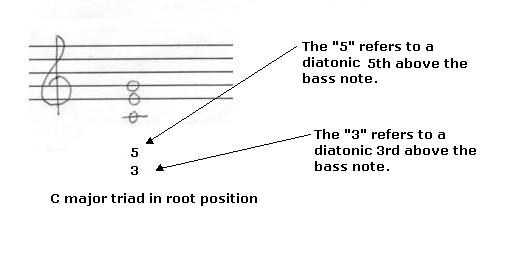 A diatonic 5th above C is a G while a
diatonic 3rd above C is an E. Hence,
we get a nice C major triad in root position and close voicing.
This terminology results from the way triads and chords were originally notated for keyboard
players back in the baroque period (1600 - 1750) in Europe. This method is called figured
bass and according to the Harvard Dictionary of Music it was a way of...
A diatonic 5th above C is a G while a
diatonic 3rd above C is an E. Hence,
we get a nice C major triad in root position and close voicing.
This terminology results from the way triads and chords were originally notated for keyboard
players back in the baroque period (1600 - 1750) in Europe. This method is called figured
bass and according to the Harvard Dictionary of Music it was a way of...
" ...indicating an accompanying part
by the bass notes only, together with figures (numbers) designating the chief intervals and chords to be played
above the bass notes."
We won't use this notation much, but it is good to be aware of it.
Now, if we take our root position C major triad in close voicing and raise the lowest note in the structure up
one octave we get a major triad in first inversion. That is, the
3rd of the chord is now in the bass. In figured bass notation, this is called a
six-three voicing.
If we apply this process to the six-three voicing we get a second inversion
major triad. That is, the 5th of the chord is in the bass. In figured bass notation this is called
a six-four voicing. Consult the following diagram.
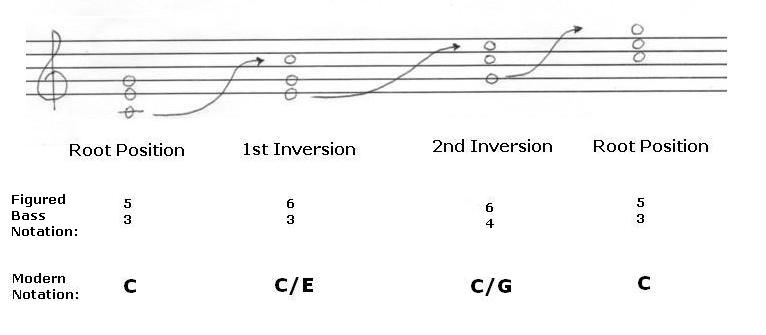 Chord inversions, on the guitar and other instruments, in general can be voiced in many different ways, but these are the only 3 possible ways to arrange
triads in close position. What you should also understand is that "first inversion" equates to "the 3rd of the
chord is in the bass," and "second inversion" means "the 5th of the chord is in the bass." We use the modern
"slash notation" to represent these structures. C/E means a C major triad with an E (the 3rd) in the bass.
And C/G means a C major triad with a G (the 5th) in the bass.
All triads can be arranged in these 3 ways. Here are some more examples:
Chord inversions, on the guitar and other instruments, in general can be voiced in many different ways, but these are the only 3 possible ways to arrange
triads in close position. What you should also understand is that "first inversion" equates to "the 3rd of the
chord is in the bass," and "second inversion" means "the 5th of the chord is in the bass." We use the modern
"slash notation" to represent these structures. C/E means a C major triad with an E (the 3rd) in the bass.
And C/G means a C major triad with a G (the 5th) in the bass.
All triads can be arranged in these 3 ways. Here are some more examples:
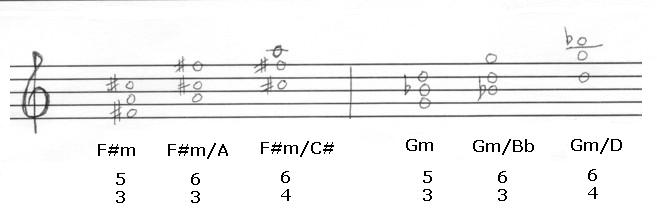
How to Play These Suckers on a Guitar
Here are the shapes in a nutshell. A nice way to play these structures is with 3 notes at a time using 3 adjacent
strings on the guitar. This gives us 4 "paths" through the shapes. The 4 sets of
3 adjacent strings are:
-
6 5 4
(the 6th, 5th, and 4th string of the guitar)
-
5 4 3
(the 5th, 4th, and 3rd string of the guitar)
-
4 3 2
(the 4th, 3rd, and 2nd string of the guitar)
-
3 2 1
(the 3rd, 2nd, and 1st string of the guitar)
I leave the fingerings up to you. There are no strict rules, only some guidelines:
Strive for efficiency, comfort and a good tone.
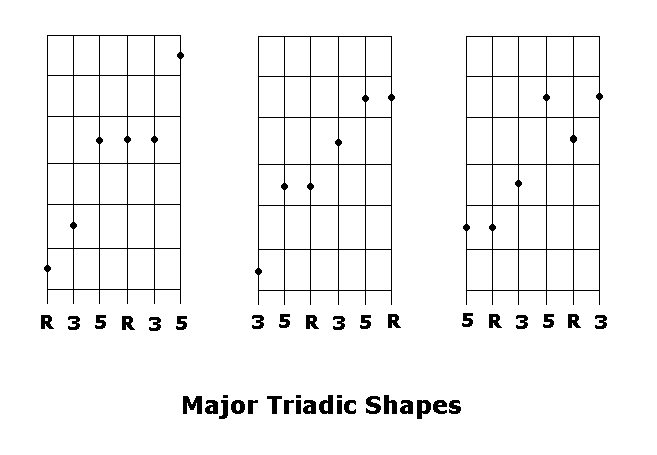
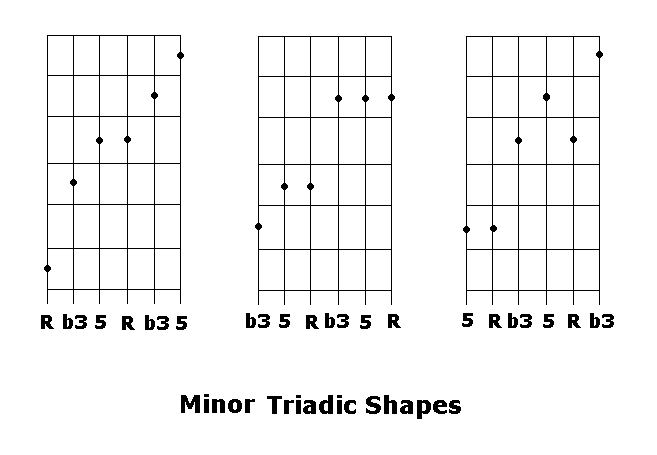
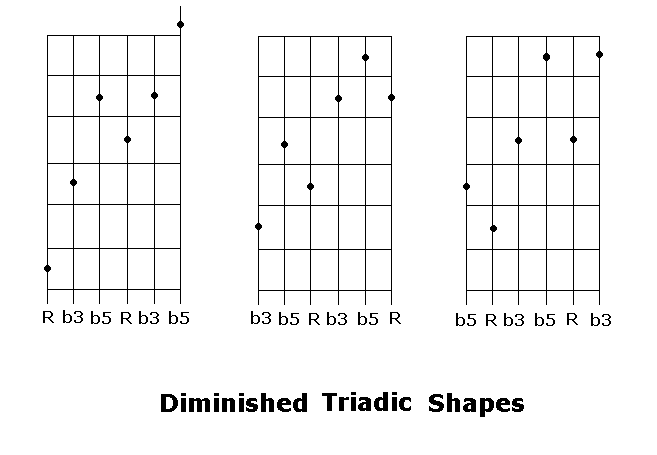
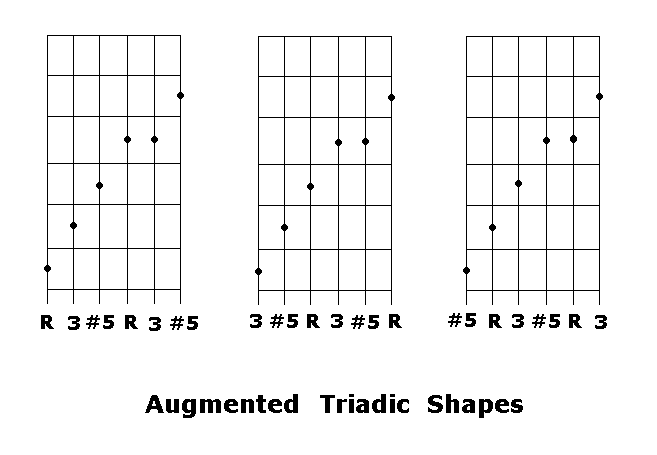 Practice these shapes so that you can play any triad in any position on the guitar in any inversion.
Play each triad in two ways: using the same set of 3-adjacent strings and moving horizontally along
the three different patterns for the particular chord you are playing, or play them by sticking with one big
pattern and jumping around on the 4 sets of 3-adjacent strings (playing vertically.)
These shapes, incidentally, happen to be basically the same shapes for arpeggios. An
arpeggio is just a fancy name that equates to playing chord tones one at a time.
Also, notice the 3 shapes for an augmented triad - they are all the same! Refer to the
previous lesson for an explanation as the why this is so.
Enjoy.
Practice these shapes so that you can play any triad in any position on the guitar in any inversion.
Play each triad in two ways: using the same set of 3-adjacent strings and moving horizontally along
the three different patterns for the particular chord you are playing, or play them by sticking with one big
pattern and jumping around on the 4 sets of 3-adjacent strings (playing vertically.)
These shapes, incidentally, happen to be basically the same shapes for arpeggios. An
arpeggio is just a fancy name that equates to playing chord tones one at a time.
Also, notice the 3 shapes for an augmented triad - they are all the same! Refer to the
previous lesson for an explanation as the why this is so.
Enjoy.
Go to the next lesson, Lesson 13, or go back to the
main menu.







